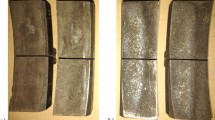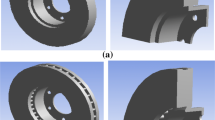Abstract
In the present review, we discuss works that have been published in the last 15–20 years that are devoted to the analysis of mathematical computational models of thermal properties of braking friction systems of various types. New applications of the theory of heat conduction and thermoelasticity as well as the rapid development of computer engineering have led to a considerable increase in the number of solvable problems, and the refining of mathematical methods and approaches enables one to construct analytic solutions of these problems. In the paper, we outline the main directions of investigation of the processes of interaction of bodies with regard for heat release. We describe analytic methods in more detail as compared with other approaches, because, to our mind, they are very promising for deriving simple engineering relations for braking processes on the basis of the equations of the thermal dynamics of friction.
Similar content being viewed by others
REFERENCES
A. V. Chichinadze, R. M. Matveevskii, É. D. Braun, et al., Materials in Tribotechniques of Nonstationary Processes [in Russian], Nauka, Moscow (1986).
P. N. Bogdanovich, V. M. Belov, and P. V. Sysoev, “Temperature on local sections of a sliding contact,” Trenie Iznos, 14, No. 5, 842–850 (1993).
A. V. Chichinadze, É. D. Braun, A. G. Ginzburg, and Z. V. Ignat'eva, Analysis, Testing, and Selection of Friction Couples [in Russian], Mashinostroenie, Moscow (1967).
I. V. Kragel'skii, M. N. Dobychin, and V. S. Kombalov, Bases of Friction and Wear Analysis [in Russian], Mashinostroenie, Moscow (1977).
V. A. Balakin and V. P. Sergienko, “Tests of materials for friction heat resistance,” Trenie Iznos, 17, No. 2, 194–201 (1996).
N. B. Demkin and É. V. Ryzhov, Surface Quality and Contact of Details of Machines [in Russian], Mashinostroenie, Moscow (1981).
A. V. Chichinadze, Analysis and Investigation of External Friction under Braking [in Russian], Nauka, Moscow (1970).
H. Blok, “Fundamental mechanical aspects in boundary lubrication,” SAE Trans., 46, 54–68 (1940).
T. C. Jaeger, “Moving sources of heat and the temperature of sliding contact,” Proc. Roy. Soc. N.S.W., 56, Pt. 3, 203–224 (1942).
A. G. Ginzburg, A. V. Chichinadze, “Application of the equations of the thermal dynamics of friction to calculation of the operating characteristics of brakes,” in: Thermal Dynamics of Friction [in Russian], Nauka, Moscow (1970), pp. 7–17.
A. G. Ginzburg, “Theoretical and experimental bases of analysis of a single process of braking with the use of a system of equations of the thermal dynamics of friction,” in: Optimal Use of Friction Materials in Friction Units of Machines [in Russian], Nauka, Moscow (1973), pp. 33–105.
A. V. Chichinadze, A. G. Ginzburg, and I. P. Kortauli, “Analysis of the operating characteristics of brakes in the intermittent mode of operation with the use of a system of equations of the thermal dynamics of friction,” in: Optimal Use of Friction Materials in Friction Units of Machines [in Russian], Nauka, Moscow (1973), pp. 108–112.
V. N. Parfenov and S. S. Kokonin, “Temperature field in friction couples in the case of short-term braking,” in: Optimal Use of Friction Materials in Friction Units of Machines [in Russian], Nauka, Moscow (1973), pp. 124–129.
V. A. Balakin, V. P. Sergienko, and O. Yu. Komkov, “Dynamic processes that appear in applying clutches and brakes,” Trenie Iznos, 17, No. 4, 463–469 (1996).
V. A. Balakin, V. P. Sergienko, and O. Yu. Komkov, “Heat processes that appear in applying friction clutches and brakes,” Trenie Iznos, 17, No. 5, 589–597 (1996).
V. N. Parfenov, S. S. Kokonin, and I. V. Yudiel', “Temperature field in friction brake disks after a single short-term braking (the process of cooling),” in: Thermal Dynamics and Simulation of External Friction [in Russian], Nauka, Moscow (1975), pp. 25–31.
V. A. Kuliev, A. P. Begidmonova, and A. V. Chichinadze, “Analysis of the heat mode of operation of a band brake,” in: Analysis and Simulation of Brake and Friction Assemblies [in Russian], Nauka, Moscow (1974), pp. 15–20.
A. G. Ginzburg, A. M. Romashko, and V. F. Titarenko, “Analysis of the temperature mode of a disk railroad brake,” in: Analysis and Simulation of Brake and Friction Assemblies [in Russian], Nauka, Moscow (1974), pp. 21–25.
A. G. Ginzburg and A. V. Chichinadze, “On the analysis of wear in the process of braking with the use of a system of equations of the thermal dynamics of friction,” in: Friction and Wear of Friction Materials [in Russian], Nauka, Moscow (1977), pp. 26–30.
M. A. Mamkhegov, Z. V. Ingnat'eva, and A. G. Ginzburg, “Problems of evaluation of the maximum temperature on nonstationary friction with intensive heat generation,” in: Friction and Wear of Friction Materials [in Russian], Nauka, Moscow (1977), pp. 46–53.
D. M. Rowson, “The interfacial surface temperature of a disc brake,” Wear, 47, No. 2, 323–328 (1978).
M. P. Aleksandrov and A. A. Nosko, “Analysis of heating of brake units with a small coefficient of mutual overlap (by the example of disk-shoe brakes of hoisting-transport facilities),” Trenie Iznos, 14, No. 5, 895–901 (1993).
A. A. Yevtushenko and E. G. Ivanyk, “Determination of heat and thermal distortion in braking systems,” Wear, 185, No. 1–2, 159–165 (1995).
E. V. Kovalenko, O. O. Evtushenko, and E. G. Ivanik, “On the calculation of temperature on braking,” Trenie Iznos, 17, No. 4, 435–441 (1996).
V. A. Galazyuk, O. O. Evtushenko, and I. N. Turchin, “Nonstationary friction heating of the bulges of microinhomogeneities of a sliding contact,” Inzh.-Fiz. Zh., 69, No. 5, 768–772 (1996).
M. V. Korovchinskii, “Bases of the theory of thermal contact in the case of local friction. Part 1,” in: Problems of Friction and Lubricant [in Russian], Nauka, Moscow (1966), pp. 98–145.
O. O. Evtushenko and E. G. Ivanik, “Nonstationary distribution of the friction temperature in the vicinity of a unit spot of touch of tips of microinhomogeneities,” Trenie Iznos, 15, No. 6, 949–957 (1994).
O. O. Evtushenko and E. H. Ivanyk, “Investigation of thermal modes on friction braking,” Izv. Ros. Akad. Nauk, Mekh. Tverd. Tela, No. 6, 73–81 (1995).
A. A. Yevtushenko and R. B. Chapovska, “Axisymmetric contact problem during braking with friction heating and wear,” J. Theor. Appl. Mech., 36, No. 2, 331–346 (1988).
A. A. Yevtushenko and E. G. Ivanyk, “Effect of the rough surface on the transient friction temperature and thermal stresses near a single contact area,” Wear, 197, No. 1–2, 160–168 (1996).
B. Gecim and W. O. Winer, “Transient temperature in the vicinity of an asperity contact,” ASME J. Tribol., 107, No. 3, 333–334 (1985).
A. I. Sviridenok, S. A. Chizhik, and M. I. Petrokovets, Mechanics of Discrete Friction Contact [in Russian], Nauka i Tékhnika, Minsk (1990).
O. O. Evtushenko, E. H. Ivanyk, and N. V. Horbachova, “Temperature and stresses in the vicinity of a friction contact of microbulges in the process of braking,” Fiz.-Khim. Mekh. Mater., 32, No. 6, 72–80 (1996).
O. O. Evtushenko, N. V. Horbachova, and E. H. Ivanyk, “Simulation of a thermal stressed state in the vicinity of a unit contour region of a friction contact with regard for roughness,” in: Abstracts of the All-Ukrainian Scientific Conf. “Development and Use of Mathematical Methods in Scientific and Research Investigations” Dedicated to the 70th Birthday of Prof. P. S. Kazymirs'kyi [in Ukrainian], (Lviv, October 1995), Part 3, Lviv (1995), p. 32.
A. A. Evtushenko, E. G. Ivanik, and N. V. Gorbachova, “Influence of convective cooling on the temperature and stressed state on braking,” Trenie Iznos, 18, No. 5, 949–957 (1997).
O. O. Evtushenko, N. V. Gorbachova, and E. G. Ivanik, “Heating of a multilayer half space by friction heat,” Mat. Met. Fiz.-Mekh. Polya, 40, No. 1, 111–116 (1997).
A. A. Evtushenko, N. V. Horbachova, and E. H. Ivanyk, “Thermomechanical processes in the case of friction heating of disk brakes,” Inzh.-Fiz. Zh., 70, No. 1, 111–116 (1997).
N. V. Horbachova, “Calculation of the temperature field of friction elements on braking,” in: Boundary-Value Problems of Thermomechanics [in Ukrainian], Part 1, Institute of Mechanics of the Ukrainian Academy of Sciences, Kiev (1996), pp. 113–116.
J. R. Barber, “Thermoelastic contact of a rotating sphere and a half-space,” Wear, 35, No. 2, 282–289 (1975).
N. V. Horbachova, “Determination of thermal modes on friction braking,” in: Bulletin of the “L'vivs'ka Politekhnika” State University, Prikl. Mat. [in Ukrainian], No. 341, “L'vivs'ka Politekhnika” State University, Lviv (1998), pp. 98–101.
Author information
Authors and Affiliations
Rights and permissions
About this article
Cite this article
Evtushenko, O.O., Ivanyk, E.H. & Horbachova, N.V. Analytic Methods for Thermal Calculation of Brakes (Review). Materials Science 36, 857–862 (2000). https://doi.org/10.1023/A:1011334721154
Issue Date:
DOI: https://doi.org/10.1023/A:1011334721154




